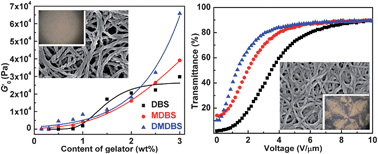High modulus and low-voltage driving nematic liquid-crystalline physical gels for light-scattering displays
Abstract
Liquid-crystalline (

* Corresponding authors
a
Key Lab for Large-Format Battery Materials and Systems, Ministry of Education, School of Chemistry and Chemical Engineering, Huazhong University of Science and Technology, Wuhan 430074, China
E-mail:
ygliao@mail.hust.edu.cn
Fax: +86-27-87543632
Tel: +86-27-87558194
b
National Anti-counterfeit Engineering Research Center, Huazhong University of Science and Technology, Wuhan 430074, China
E-mail:
xlxie@mail.hust.edu.cn
Fax: +86-27-87543632
Tel: +86-27-87559644
Liquid-crystalline (

 Please wait while we load your content...
Something went wrong. Try again?
Please wait while we load your content...
Something went wrong. Try again?
S. Bi, H. Peng, S. Long, M. Ni, Y. Liao, Y. Yang, Z. Xue and X. Xie, Soft Matter, 2013, 9, 7718 DOI: 10.1039/C3SM50929J
To request permission to reproduce material from this article, please go to the Copyright Clearance Center request page.
If you are an author contributing to an RSC publication, you do not need to request permission provided correct acknowledgement is given.
If you are the author of this article, you do not need to request permission to reproduce figures and diagrams provided correct acknowledgement is given. If you want to reproduce the whole article in a third-party publication (excluding your thesis/dissertation for which permission is not required) please go to the Copyright Clearance Center request page.
Read more about how to correctly acknowledge RSC content.
 Fetching data from CrossRef.
Fetching data from CrossRef.
This may take some time to load.
Loading related content
